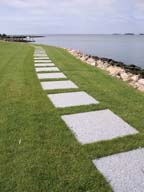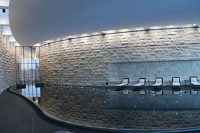

The site for the project, which sits beside Rothberg's home, was a former granite quarry that had been filled in years ago. In determining what to do with the property, Rothberg was referred to sculptor Darrell Petit by renowned architect Cesar Pelli. “He had the idea to create a sophisticated astrological clock,†Petit explained. “It is based on certain astro-archeological concepts of Stonehenge. We did not deny history. I visited Stonehenge numerous times to learn from the concepts, from the stone usage and from the experience of the site to be able to create our project specific to our site and our ideas.â€
Ultimately, this project would utilize over 700 tons of Blue Pearl Fjord granite, quarried by Lundhs Labrador AS of Larvik, Norway. “We wanted to build a monolith with the greatest ability to predict solar and celestial events,†Petit said. “Think of the Circle of Life as a complex watch -- a modern day monolith that exhibits beauty and functionality and demonstrates that these structures can function as powerful astrological instruments with substantial predictive abilities. I helped give form and material to the idea, and it started to become a reality in our minds. Then there was the next part of the process of finding the team and of orchestrating the process to build it.â€
Assembling the right team for an undertaking of this magnitude took careful consideration. “This project was proposed to a number of different people, and I was surprised at the apprehension that we met,†Petit said. “And yet the great thing about that apprehension was that it narrowed it down to only those people who were truly capable and truly enthusiastic, and were capable of elevating to another level of thinking. [Lundhs] wanted to do it, they understood how it had to be done, and they were willing to accept the challenge.â€
Like many collaborators on the venture, Petit and Lundhs have had a long professional association, having worked together on various projects for the past 15 years. “I wanted a similarity to the building of ancient monuments,†Petit said. “Thor Lundh and Kjell Hobaek of Lundhs embraced that concept enthusiastically.â€
The specific variety of stone related to the site and to its ultimate goals. “Considering the flat area of the expansive waterfront property -- with evidence of granite ledges and wide open to the sky and wide open to the Long Island Sound -- helped us to source the stone. We wanted a granite that would endure the 10,000 years and that would act gravitationally on the site,†the sculptor said. “We also wanted a stone with the energy of millions of years that would reflect the sun and stars of the expansive universe. The Blue Pearl Fjord granite has the capacity to reflect light and has a crystal structure that relates to the cosmos. The white veining of the stone shows a similarity to what we see when we look at the sky at night.â€
A quarry consultant, Adler, was hired to supervise the extraction process. “It was explained [to the quarry workers] that the quarrying of these blocks would be different, and they understood the scope and importance of the project.â€
The upright pieces are 4 x 2 x 1 meters in size, and the lintels are 3.3 x 0.66 x 1 meters. In all, there are 20 uprights and 12 lintels. In detailing the stone, maintaining evidence of the quarry process was an important consideration. “It was not my role to negate that, but to enhance it,†Petit said, adding that the blocks are polished on one side, but feature the original drill marks on all of the others. These marks, while rough, reveal “the best [quarrying] technology of our time.†Most of the drill marks run horizontally, while others are vertically or diagonally. “We wanted to add eccentricity within the whole,†Petit said. “We didn't want it to be static.â€
To complete the project, Petit spent three months in Norway. While overseas, he had three assistants working with him -- including Martin Kuhn and Jasmin Hurst of Germany and Thomas Cleveland of the U.S. The polish was obtained by hand with Flex and Makita tools. “We had four people working on a single block, rather than doing it individually,†he said, adding that it typically took 2 1â„2 days per block.
The sawn face of the material was polished to a 1,000 grit, and the surface retains the natural undulation of the stone. These variations in the surface reflect the light in a very specific way, as opposed to a machine-polished surface. “It is reflective, but it holds the light rather than harden and reflect it,†Petit said. “This also retains the three-dimensionality of the block.â€
Each block used for the Circle of Life is unique, and a model was created for each block in the design to determine their eventual placement in the project as a whole. The models portrayed the block's dimensions, drill pattern, veining and edge conditions (some have broken edges, while others are split or drilled). The blocks were placed in terms of their relationship to the site as well as their relationship to each other.
Another goal was to ensure that the stonework would endure for generations to come. “We did everything -- including working with Laticrete [on custom adhesives] -- to make sure this would be here for at least 10,000 years,†Petit said.
Other professionals from outside the stone sector also contributed to the Circle of Life. “I had never been involved in anything that had to 'work' before, so we needed to consult Dr. Anthony Aveni, who is an expert in the [astronomy] field,†Petit explained. “His knowledge influenced the siting of the Circle, and then it changed again and again over time based on everyone's expertise. It was truly a collaborative project. Though we were dealing with astro-archeology, it was as important to develop the project from the ground up so that the specific site conditions influenced our usage of stone.â€
Within the circle, the design features seven “Sarsen Stones,†which relate to celestial activity. These Sarsen Stones were hand pointed to create the desired aesthetic. Additionally, there are seven Blue Pearl boulders that were carefully placed further from the site to recall glacial erratics. “Even if you are on the outer property, you still relate back to the site.â€
Also, the same granite was used in a flamed format to pave a walkway along the Long Island Sound. “We wanted all surfaces present -- drilled, split, polished, flamed and hand pointed,†Petit said.
Practical issues
The massive blocks used for the Circle of Life were worked to exacting tolerances -- within 3 cm -- and the layout needed to be very specific for the project to function properly.Weight was another major issue, as the uprights weigh 22.5 tons apiece. All of the blocks were shipped into the Port of New Haven in Connecticut, and they had to be packed with extreme caution. Also, Petit and his team had to “convey to everyone involved in the transport that these were not raw blocks, but were done to very specific tolerances and polish levels.â€
After the stone arrived in New Haven, it was received by Gateway Terminal and “taken to the site deliberately and slowly; not in a flood of trucks,†according to Petit, who said they wanted to be sure not to disrupt the residential neighborhood in which the project is set. The delivery plan allowed Petit to select certain blocks to be delivered in sequence, and it took a total of seven days for the stone to be delivered from the port to the site.
Carl Marino Crane, which has a long-term working relationship with Petit, took the blocks from the port and completed the installation. “The people were inspired in their work,†he said. “The material handling was thoughtful.â€
Prior to setting the granite, the ground underneath the site was reinforced with concrete. “The concrete goes all the way to the bedrock in some places, but it varied based on the old [quarry] condition,†Petit said, adding that the concrete fill ranged from 2 feet to as much as 25 feet in some areas.
The formal opening of the Circle of Life took place in July of 2004, although the overall property is still being developed with the construction of a new home. Petit said that the “sculpture will inform the architecture†of the residence, and that the Circle of Life has blended seamlessly into the landscape. “This project appears to have to have grown there, or have been there for some time, and that's really what you want. Not only does the project belong, but it looks as if it has been birthed there.â€
